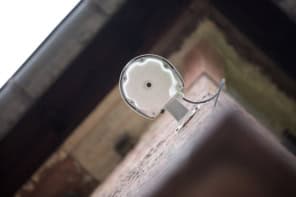
Scientists from France have used muon-imaging techniques to carry out a 3D reconstruction of a nuclear reactor. The researchers say that the technique, the first time it has been used in such a way, could be extended to non-destructively image other large objects.
Muons are charged subatomic particles that are around 200 times heavier than electrons. Muon radiography – or muography – analyses how muons in cosmic rays penetrate objects and exploits this information to produce 2D images. The technique is similar to X-ray radiography used in medical imaging with the cosmic-ray radiation taking the place of artificially-generated X-rays and muon trackers the place of radiographic plates.
Depending on their energy, muons can traverse metres of rock or other materials, making them ideal for imaging thick and large structures. Indeed, the technique has been successfully used in the past to produce 2D images of nuclear reactors, pyramids and volcanoes.
Determining local densities
In their latest work, researchers led by Sébastien Procureur from the Université Paris-Saclay and the French Alternative Energies and Atomic Energy Commission (CEA), used four telescopes to observe a decommissioned nuclear reactor in France from different angles. They then combined the different 2D images to obtain the 3D structure of the reactor using a modified tomography reconstruction algorithm that was originally developed for medical applications.
“Each image provides a measure of the density of the object, but integrated in the direction of observation,” explains Procureur. “By moving the telescopes, we can access a large number of densities integrated in different directions and can then determine the local densities.”
The technique was able to produce an accurate 3D reconstruction of the nuclear reactor. “Compared to medical imaging, in which the volume to be imaged is much smaller and the number of available 2D images is several hundred or even several thousand, we have shown in our work that we can obtain relatively precise 3D information on an object that is more than 30 m long with less than just 30 images,” says Procureur.
He adds that while the technique will never be able to resolve small cracks in such structures, the information obtained remains inaccessible with other non-invasive methods. The muon technique could be used to image reactors, either in operation or during their decommissioning phase. Indeed, it could be help in post-accident inspections, such as those carried out after the Fukushima accident.

Cosmic muons probe the interiors of tropical cyclones
Beyond nuclear reactors, the method could also be of interest for soil studies, prospecting mines to locate ores, civil engineering and archaeology. The researchers, who report their work in Science Advances, say they are now working on analysing another reactor to improve the accuracy of their 3D reconstruction. “There is still much work to be done on optimizing the measurements,” says Procureur.
The team also hopes to work on other applications of muon imaging. In 2015, the researchers proposed an experiment to monitor the water level in a water tower using muons and a few years later, a company asked them to apply the technique to remotely monitoring water levels in reactor pools. “If we hadn’t done our experiment in 2015, the company would never even have known that such a technique existed,” says Procureur. “I believe it is essential to continue with experiments that may, at first glance, seem far-fetched.”



